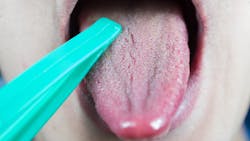Loss of smell and taste: Distinguishing between COVID-19 and the common cold/flu
Temporary loss of smell, anosmia, and taste, ageusia, are two symptoms that can differentiate COVID-19 from the common cold and flu, according to a new statement by the US Surgeon General Jerome Adams, MD, MPH.1 These two symptoms are also some of the earliest and most commonly reported indicators of COVID-19 and may better predict positivity compared with other symptoms such as fever and cough.
COVID-19 patients are 27 times more likely to experience the loss of smell, but only around 2.2 to 2.6 times more likely to have fever, cough, or respiratory difficulty, compared to those without COVID-19. An average of 47% (up to 80%) of people who test positive for COVID-19 can have subjective complaints of smell or taste loss.2 That percentage rises when these patients are tested using objective methods that measure the function of smell. Most patients first notice problems with their sense of smell; however, because smell is necessary to taste flavor, the symptoms are often connected.
According to one Italian report, out of 187 patients having a mild form of COVID-19 and not requiring hospitalization, 113 reported an alteration when asked to rate their sense of smell or taste. One month after initial positive diagnosis, 55 patients reported full recovery of taste and smell, 46 reported symptom improvement, and 12 reported no change or worsening of symptoms.3
Further reading:
Another retrospective study showed that COVID-19 patients with normal smell function appeared to have a worse course of disease and were more likely to be hospitalized and placed on a ventilator.4 This suggests that patients who experience smell dysfunction may have a milder form of COVID-19 or for the most part be asymptomatic. The data also suggests that in a substantial percentage of the COVID-19–infected population, smell loss can be one of the first, or only, signs of disease which can be important to recognize in a largely asymptomatic younger population.
Although the exact mechanism behind the virus’ effect on smell and taste is elusive, one study suggests that the novel coronavirus changes the sense of smell/taste in patients not by directly infecting neurons but by affecting the function of supporting cells.5 Temporary loss of function of supporting cells in the olfactory epithelium, which indirectly causes changes to olfactory sensory neurons, results in symptomatic changes. According to lead author Sandeep Robert Datta, MD, PhD, “I think it’s good news, because once the infection clears, neurons don’t appear to need to be replaced or rebuilt from scratch,” which can take a longer period of time.
Protocol for managing patients with loss of taste and/or smell
The management of patients with sudden loss of taste/smell due to COVID-19 includes the following guidelines6:
- Patients with an isolated loss of smell for less than three months may be managed by their general physician, and referral to an ENT after three months is recommended.
- Smell training should be recommended for all patients with loss of smell persisting for more than two weeks.
- An MRI of the brain is not recommended for patients with a loss of smell associated with COVID‐19 infection regardless of the duration of the loss of smell.
- Olfactory training is recommended for patients who experience a loss of smell for more than two weeks.
References
- Martin M. U.S. Surgeon General blames ‘pandemic fatigue’ for recent COVID-19 surge. NPR. November 14, 2020. https://www.npr.org/transcripts/934986232
- Agyeman AA, Chin KL, Landersdorfer CB, Liew D, Ofori-Asenso R. Smell and taste dysfunction in patients with COVID-19: a systematic review and meta-analysis. Mayo Clin Proc. 2020;95(8):1621-1631. doi:10.1016/j.mayocp.2020.05.030
- Mundasad S. Coronavirus: sense of smell and taste ‘improve for most.’ BBC News. July 2, 2020. https://www.bbc.com/news/health-53265280
- Yan CH, Faraji F, Prajapati DP, Ostrander BT, DeConde AS. Self‐reported olfactory loss associates with outpatient clinical course in COVID‐19. Int Forum Allergy Rhinol. 2020;10(7):821-831. doi:10.1002/alr.22592
- Brann DH, Tsukahara T, Weinreb C, et al. Non-neuronal expression of SARS-CoV-2 entry genes in the olfactory system suggests mechanisms underlying COVID-19–associated anosmia. Sci Adv. 2020;6(31):eabc5801. doi:10.1126/sciadv.abc5801
- Hopkins C, Alanin M, Philpott C, et al. Management of new onset loss of sense of smell during the COVID‐19 pandemic – BRS consensus guidelines. Clin Otolaryngol. 2020;00:1-7. doi:10.1111/coa.13636
Related reading:
- Vitamin D deficiency and COVID-19
- Lowering the transmission and spread of human coronavirus with over-the-counter products
- How does COVID-19 affect salivary flow and xerostomia?
- Can periodontal disease be a contributing factor for COVID-19 severity?
Editor’s note: This article originally appeared in Perio-Implant Advisory, a newsletter for dentists and hygienists that focuses on periodontal- and implant-related issues. Perio-Implant Advisory is part of the Dental Economics and DentistryIQ network. To read more articles, visit perioimplantadvisory.com and subscribe at this link.
About the Author

Scott Froum, DDS
Editorial Director
Scott Froum, DDS, a graduate of the State University of New York, Stony Brook School of Dental Medicine, is a periodontist in private practice at 1110 2nd Avenue, Suite 305, New York City, New York. He is the editorial director of Perio-Implant Advisory and serves on the editorial advisory board of Dental Economics. Dr. Froum, a diplomate of both the American Academy of Periodontology and the American Academy of Osseointegration, is a volunteer professor in the postgraduate periodontal program at SUNY Stony Brook School of Dental Medicine. He is a PhD candidate in the field of functional and integrative nutrition. Contact him through his website at drscottfroum.com or (212) 751-8530.
